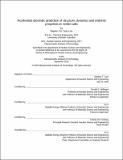| dc.contributor.advisor | Ronald G. Ballinger and Ju Li. | en_US |
| dc.contributor.author | Lam, Stephen Tsz Tang. | en_US |
| dc.contributor.other | Massachusetts Institute of Technology. Department of Nuclear Science and Engineering. | en_US |
| dc.date.accessioned | 2021-01-06T17:40:33Z | |
| dc.date.available | 2021-01-06T17:40:33Z | |
| dc.date.copyright | 2020 | en_US |
| dc.date.issued | 2020 | en_US |
| dc.identifier.uri | https://hdl.handle.net/1721.1/129108 | |
| dc.description | Thesis: Ph. D., Massachusetts Institute of Technology, Department of Nuclear Science and Engineering, September, 2020 | en_US |
| dc.description | Cataloged from student-submitted PDF version of thesis. | en_US |
| dc.description | Includes bibliographical references (pages 122-142). | en_US |
| dc.description.abstract | Various advanced nuclear reactors including fluoride high-temperature salt-cooled reactors (FHRs), molten salt reactors (MSRs) and fusion devices have proposed to use molten salt coolants. However, there remain many uncertainties in the chemistry, dynamics and physicochemical properties of many salts, especially over the course of reactor operation, where impurities are introduced, and compositional and thermodynamic changes occur. Density functional theory (DFT) and ab initio molecular dynamics (AIMD) were used for property, structure and chemistry predictions for a variety of salts including LiF, KF, NaF, BeF2, LiCl, KCl, NaCl, prototypical Flibe (66.6%LiF-33.3%BeF2), and Flinak (46.5%LiF-11.5NaF-42%KF). Predictions include thermophysical and transport properties such as bulk density, thermal expansion coefficient, bulk modulus, and diffusivity, which were compared to available experimental data. | en_US |
| dc.description.abstract | DFT consistently overpredicted bulk density by about 7%, while all other properties generally agreed with experiments within experimental and numerical uncertainties. Local structure was found to be well predicted where pair distribution functions showed similar first peak distances (+ 0.1 A) and first shell coordination numbers (+ 0.4 on average), indicating accurate simulation of chemical structures and atomic distances. Diffusivity was also generally well predicted within experimental uncertainty (+20%). Validated DFT and AIMD methods were applied to study tritium in prototypical salts since it is an important corrosive and diffusive impurity found in salt reactors. It was found that tritium species diffusivity depended on its speciation (TF vs. T2), which was related to chemical structures formed in Flibe and Flinak salts. Further, predictions allowed comparison with and interpretation of past contradictory experimental results found in the literature. | en_US |
| dc.description.abstract | Lastly, robust neural network interatomic potentials (NNIPs) were developed for LiF and Flibe. The LiF NNIP accurately reproduced DFT calculations for pair interactions, solid LiF and liquid molten salt. The Flibe NNIP was developed for molten salt at the reactor operating temperature of 973K and was found to reproduce local structures calculated from DFT and showed good stability and accuracy during extended MD simulation. Ab initio methods and NNIPs can play a major role in advanced reactor development. Combined with experiments, these methods can greatly improve fundamental understanding and accelerate materials discovery, design and selection. | en_US |
| dc.description.statementofresponsibility | by Stephen Tsz Tang Lam. | en_US |
| dc.format.extent | 150 pages | en_US |
| dc.language.iso | eng | en_US |
| dc.publisher | Massachusetts Institute of Technology | en_US |
| dc.rights | MIT theses may be protected by copyright. Please reuse MIT thesis content according to the MIT Libraries Permissions Policy, which is available through the URL provided. | en_US |
| dc.rights.uri | http://dspace.mit.edu/handle/1721.1/7582 | en_US |
| dc.subject | Nuclear Science and Engineering. | en_US |
| dc.title | Accelerated atomistic prediction of structure, dynamics and material properties in molten salts | en_US |
| dc.type | Thesis | en_US |
| dc.description.degree | Ph. D. | en_US |
| dc.contributor.department | Massachusetts Institute of Technology. Department of Nuclear Science and Engineering | en_US |
| dc.identifier.oclc | 1227100601 | en_US |
| dc.description.collection | Ph.D. Massachusetts Institute of Technology, Department of Nuclear Science and Engineering | en_US |
| dspace.imported | 2021-01-06T17:40:32Z | en_US |
| mit.thesis.degree | Doctoral | en_US |
| mit.thesis.department | NucEng | en_US |
